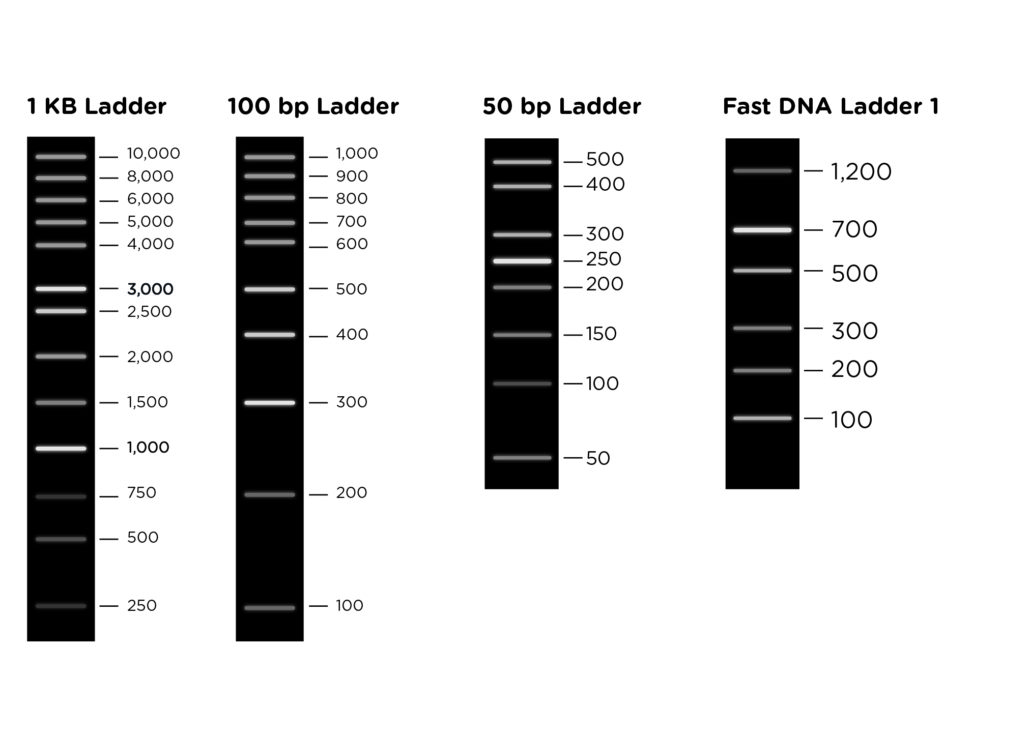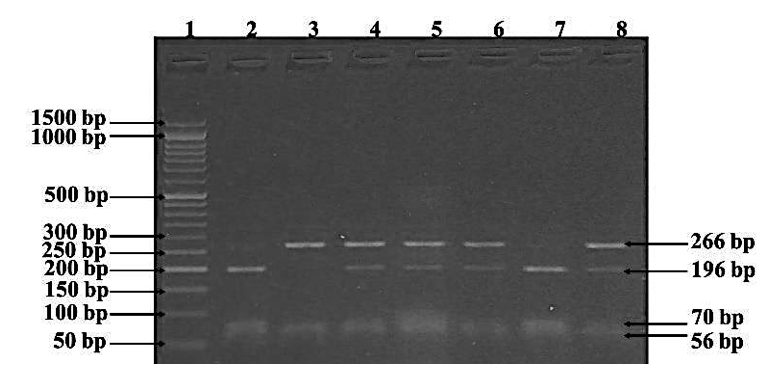DNA ladders are used to estimate the size of DNA fragments. They act as molecular rulers in gel electrophoresis.
DNA ladders are essential tools in molecular biology. They help scientists determine the length of DNA fragments. Each ladder contains DNA fragments of known sizes. These fragments serve as reference points. When running gel electrophoresis, DNA samples are compared to the ladder.
This comparison helps identify the sizes of unknown DNA fragments. Accurate fragment sizing is crucial in many experiments. It aids in gene cloning, sequencing, and genetic analysis. Using a DNA ladder ensures precise results. This makes DNA ladders vital in research and diagnostics. Their role in DNA analysis cannot be overstated.
Introduction To Dna Ladders
DNA ladders are essential tools in molecular biology. They help scientists measure DNA fragments’ sizes. These ladders contain DNA fragments of known lengths. They are used as a reference in various experiments.
Importance In Molecular Biology
DNA ladders play a crucial role in molecular biology. They provide a size standard for DNA fragments. This helps in the accurate measurement of DNA during experiments. Researchers rely on DNA ladders to compare unknown DNA samples. This ensures accurate results in genetic analysis and research.
Common Uses In The Lab
DNA ladders are commonly used in gel electrophoresis. This technique separates DNA fragments based on size. Scientists use DNA ladders to identify fragment sizes. This is essential in DNA cloning and sequencing.
Another common use is in polymerase chain reaction (PCR). DNA ladders help verify the success of PCR amplification. They also assist in determining the quantity of amplified DNA. This is important in various genetic studies and diagnostics.
| Application | Purpose |
|---|---|
| Gel Electrophoresis | Separate and measure DNA fragments |
| PCR | Verify and quantify DNA amplification |
In summary, DNA ladders are vital tools in molecular biology labs. They ensure accurate measurements and reliable results in various experiments.

Credit: www.minipcr.com
Types Of Dna Ladders
DNA ladders are essential tools in molecular biology. They help researchers estimate the size of DNA fragments. There are different types of DNA ladders, each serving a unique purpose.
Standard Dna Ladders
Standard DNA ladders are pre-determined markers. They contain DNA fragments of known sizes. These ladders help compare unknown DNA samples. Researchers often use them in gel electrophoresis. They provide a reference for estimating DNA fragment lengths.
| DNA Ladder | Fragment Sizes (bp) |
|---|---|
| 100 bp Ladder | 100, 200, 300, 400, 500, 600, 700, 800, 900, 1000 |
| 1 kb Ladder | 1000, 2000, 3000, 4000, 5000, 6000, 7000, 8000, 9000, 10000 |
Custom Dna Ladders
Custom DNA ladders are tailored to specific needs. Scientists design them for unique research projects. They can include specific fragment sizes. This makes them highly flexible and useful.
- Customizable fragment sizes
- Specific concentration requirements
- Unique ladder formulations
Custom DNA ladders offer great flexibility. They are ideal for specialized applications. They ensure precise DNA size estimation.
Preparing Dna Ladders
Preparing DNA ladders is crucial for various genetic studies. DNA ladders help in determining the size of DNA fragments. This process is essential in experiments like PCR and gel electrophoresis. Let’s explore two main methods for preparing DNA ladders.
Commercially Available Options
Many companies sell ready-made DNA ladders. These ladders come in different sizes and ranges. You can choose one based on your specific needs.
- Standard DNA ladders
- High-range DNA ladders
- Low-range DNA ladders
Commercial DNA ladders are easy to use. Just follow the instructions provided. They save time and ensure accuracy.
| Brand | Range | Price |
|---|---|---|
| Brand A | 100-2000 bp | $50 |
| Brand B | 50-1000 bp | $45 |
| Brand C | 500-3000 bp | $70 |
Diy Preparation Methods
Some prefer preparing DNA ladders at home. This method is cost-effective. You need a restriction enzyme and a known DNA source.
- Obtain a plasmid DNA source.
- Choose a suitable restriction enzyme.
- Digest the DNA with the enzyme.
- Run the digested DNA on a gel.
- Stain the gel to visualize bands.
Ensure you have the right tools. A good lab setup is essential for DIY methods.
Both commercial and DIY methods have their benefits. Choose the one that fits your needs.

Credit: www.stellarscientific.com
Applications In Gel Electrophoresis
Gel electrophoresis is a technique used to separate DNA fragments by size. DNA ladders are essential tools in this process. They help scientists visualize and measure DNA fragments accurately.
Visualizing Dna Fragments
A DNA ladder consists of DNA fragments of known lengths. These fragments serve as a reference during gel electrophoresis. Scientists load the DNA ladder alongside their samples. This helps compare the size of unknown DNA fragments.
The DNA ladder makes it easy to see the different DNA fragments. Scientists can then determine the size of each fragment by comparing it to the ladder. This is crucial for many genetic studies.
Ensuring Accuracy In Experiments
Using a DNA ladder ensures the accuracy of gel electrophoresis results. It acts as a control, helping to confirm that the gel electrophoresis process is working correctly.
The DNA ladder also helps in identifying any issues with the gel or the running conditions. If the ladder bands appear as expected, the experiment is considered accurate. Any discrepancies can be quickly identified and corrected.
This is vital for experiments that require precise DNA measurements. Accurate results are necessary for cloning, sequencing, and other genetic research.
| Purpose | Benefit |
|---|---|
| Visualizing DNA Fragments | Helps determine fragment size |
| Ensuring Accuracy | Acts as a control |
DNA ladders are indispensable in gel electrophoresis. They help visualize and ensure the accuracy of DNA fragment analysis.
Interpreting Results With Dna Ladders
Interpreting Results with DNA Ladders is crucial for molecular biology experiments. DNA ladders act as molecular rulers, helping scientists determine the size of DNA fragments. This step ensures accurate and reliable results.
Band Pattern Analysis
Band patterns appear on the gel after electrophoresis. Scientists compare the band patterns of unknown samples with the DNA ladder. This process helps identify the sizes of the DNA fragments. Each band in the ladder represents a fragment of known size. By aligning these bands with the sample bands, you can determine the approximate size of unknown DNA fragments.
| DNA Ladder Band | Sample Band | Size (bp) |
|---|---|---|
| 1 | 2 | 500 |
| 2 | 3 | 1000 |
| 3 | 4 | 1500 |
Molecular Weight Determination
The molecular weight of DNA fragments is important for various experiments. By using a DNA ladder, you can determine the molecular weight of your samples. Compare the migration distance of sample bands to the ladder bands. This comparison allows you to estimate the molecular weight. Knowing the molecular weight helps in identifying and analyzing DNA fragments accurately.
- Load the DNA ladder and samples into the gel.
- Run the gel electrophoresis.
- Visualize the bands under UV light.
- Compare sample bands with DNA ladder bands.
- Determine the molecular weight based on the comparison.
Accurate interpretation of results with DNA ladders is essential. It ensures reliable and reproducible outcomes in molecular biology experiments.
Troubleshooting Common Issues
Using DNA ladders in gel electrophoresis can sometimes present challenges. This section will help you troubleshoot common issues. Identifying and resolving problems ensures accurate results.
Smearing Problems
Smearing can distort results and make bands unclear. Follow these steps to prevent smearing:
- Ensure your gel concentration matches your DNA size.
- Use fresh and properly prepared buffer solutions.
- Avoid overloading the sample wells with too much DNA.
- Check the voltage settings on your electrophoresis unit.
| Problem | Solution |
|---|---|
| High DNA load | Reduce sample amount |
| Incorrect buffer | Use fresh buffer |
| Improper gel concentration | Adjust gel recipe |
Inconsistent Band Patterns
Inconsistent band patterns can confuse results and interpretation. Follow these tips to achieve clear bands:
- Ensure gel polymerization is complete before running samples.
- Check the quality of your DNA samples.
- Use a consistent loading technique for all wells.
- Verify the electrophoresis conditions are stable.
| Issue | Correction |
|---|---|
| Uneven gel polymerization | Allow full polymerization |
| Poor DNA quality | Use purified DNA |
| Inconsistent loading | Standardize loading |

Credit: geneticeducation.co.in
Frequently Asked Questions
What Is A Dna Ladder?
A DNA ladder is a molecular marker used to estimate the size of DNA fragments.
How Is A Dna Ladder Used?
A DNA ladder is loaded in gel electrophoresis to compare the size of unknown DNA fragments.
Why Is A Dna Ladder Important?
A DNA ladder ensures accuracy in determining the size of DNA fragments during electrophoresis.
Can Dna Ladders Be Reused?
No, DNA ladders are typically single-use to avoid contamination and ensure accurate results.
What Types Of Dna Ladders Are Available?
DNA ladders come in various sizes, including low-range, mid-range, and high-range for different fragment sizes.
Conclusion
DNA ladders are essential for molecular biology research. They help measure DNA fragment sizes. Researchers use them for accurate and reliable results. Understanding DNA ladders improves lab work efficiency. Whether in academic labs or biotech companies, DNA ladders are invaluable.
Enhance your research with this crucial tool.
Recent Posts
Maintaining clean gutters is essential for preventing water damage to your home, and choosing the best ladder for cleaning gutters can make the job much easier and safer. With so many options on the...
Best Ladder for Cleaning Caravan Roof: Top Picks for You Every Adventure!
Today we will discuss the best ladder for cleaning caravan roof. Cleaning caravan roofs is one of the crucial tasks.After many days, a caravan roof can get dirty by debris, dirt, and grime. These can...
